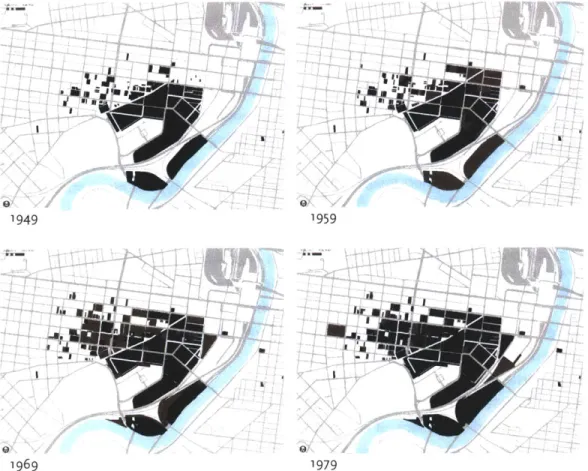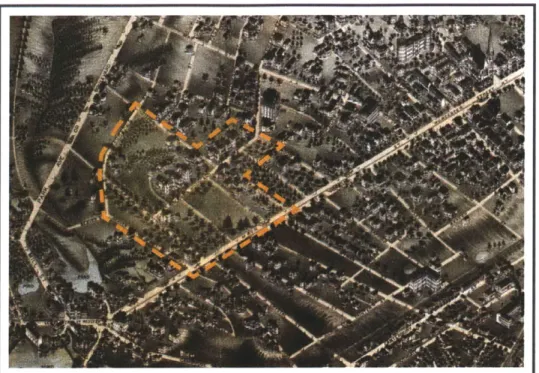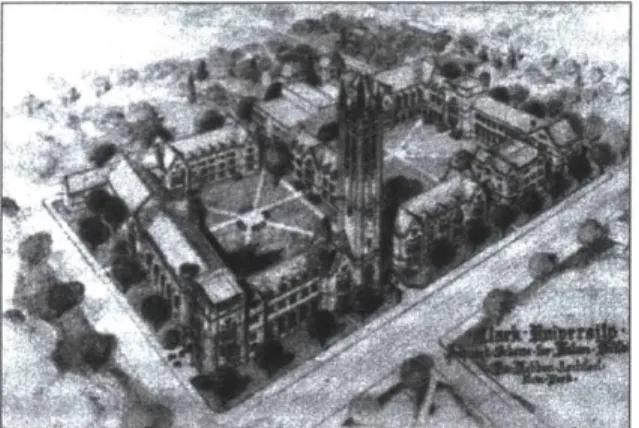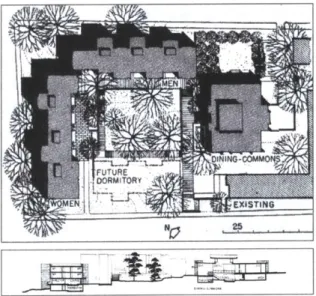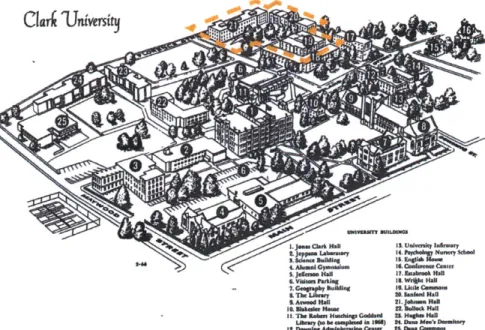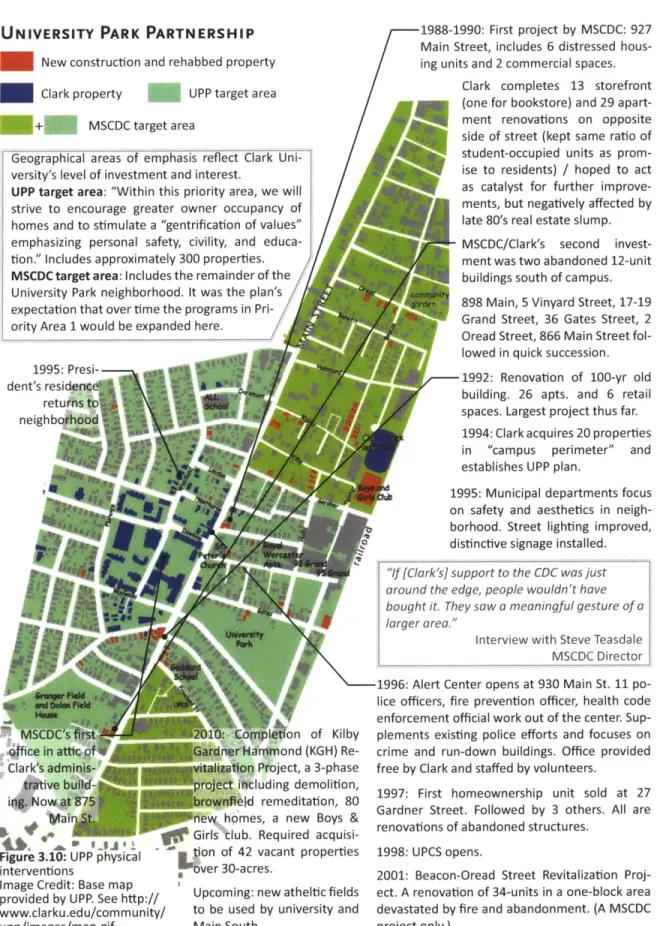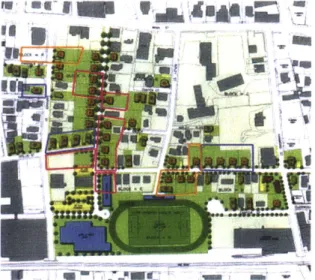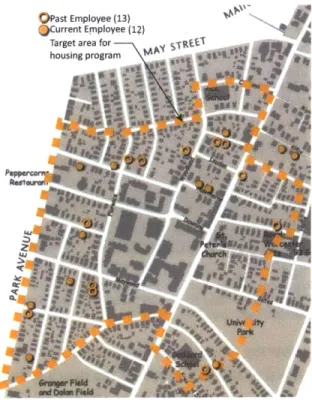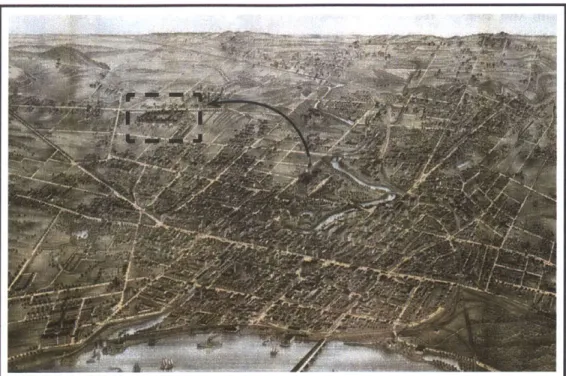Beyond the Ivory Tower:
In Search of a New Form for Campus-Community Relationships
By
Anne Bowman
Bachelor of Architecture
University of Notre Dame
Notre Dame, Indiana (2004)
MASSACHUSETTS INSTITUTE OF TECHNOLOCY
JUN 3
0
2011
LIBRARIES
ARCVES
Submitted to the Department of Urban Studies and Planning
in partial fulfillment of the requirements for the degree of
Master in City Planning
at the
MASSACHUSETTS INSTITUTE OF TECHNOLOGY
June 2011
@
2011 Anne Bowman. All Rights Reserved
The author here by grants to MIT the permission to reproduce and to distribute publicly paper
and electronic copies of the thesis document in whole or in part.
Author
Department of Urban Studies and Planning
/' May 19, 2011
Certified by
Accepted by
Professor Lawrence Vale Department of Urban Studies and Planning Thesis Supervisor
Professor Joseph Ferreira Committee Chair Department of Urban Studies and Planning
Beyond the Ivory Tower:
In Search of a New Form
for Community-University Partnerships
by
Anne Bowman
Submitted to the Department of Urban Studies and Planning
on May 19, 2011 in partial fulfillment of the requirements for the degree
of Master in City Planning at the Massachusetts Institute of Technology
ABSTRACT
The terms "ivory tower" and "town-gown" have long been used to characterize the
rela-tionship between institutions of higher education and the communities in which they reside.
While these adversarial phrases reflect the social and physical tension that has historically existed
between the two groups, the terms are no longer appropriate as colleges and universities of
today are more enlightened, realizing that as fixed and vested institutions, much of their success,
and in some cases survival, is dependent on the health of the community in which they reside.
The American college campus, where design decisions have come about as a means to engender
community and promote learning, is a physical manifestation of the institutional mission and
purpose. Therefore, as institutions look beyond their campus edges to consciously engage with
their larger community, a shift in the physical representation should follow. In this thesis, I examine
the evolution of a new physical form that reflects this changing dynamic by exploring the alignment
of the institution's mission to the design and development of the campus edge, where this
rela-tionship is most evident. Based on a review of current campus conditions, I develop a sequence
of edge conditions based on permeability and relationship between campus and community. I
then focus on urban institutions in marginalized neighborhoods that have expanded their mission
by embracing their urban setting and engaging with their communities in comprehensive
revi-talization initiatives. Using two case studies, Clark University and Trinity College, and drawing
briefly on several other examples, I consider the relationship between the current and historical
mission of the institution and the impact their recent neighborhood revitalization efforts have
had on the physical transformation of the campus edges. Applying lessons learned from these
efforts, I encourage colleges and universities to reconsider the value of their edges and promote
them as an integral part of the overall campus. Finally, I make recommendations to help
insti-tutions rethink their campus edges in a way that embraces the evolving community-university
dynamic and contributes to the well-being of both their students and surrounding neighborhood.
TABLE OF CONTENTS
Abstract
3
Acknowledgments
7
Introduction
9
Part One: The University and Civic Relationships
..---...
...
11Expansion
11Urban Universities
12
Anchor Institutions
14
A Brief History of Higher Education Institutions and Policy Initiative
15
Official Community-University Partnerships
18Focusing on the Physical Aspects of Institutional Relationships
20Part Two: Campus Planning and Urban Design
---...---
21
Introduction
21
Historic Context
22Transitioning Role of Institutions
26
Urban Renewal & Its Lasting Effects
28
Today: University as City Planner
29
Learning from Planning Practices
31
Relationship of campus planning to city design
32
Lesson from Urban Design Literature
33
Edge Conditions
34
Part Three: Case Studies Introduction
41Clark University
---...
41History
45
Impetus and Project Structure
50Revitalization Program
55
Conclusion
61
Trinity College ...---...
63
History
67
Impetus and Project Structure
73
Revitalization Program
76
Conclusion 91
Part Four: Understanding the Edge Condition ...-...
.
...
93
Conclusions and Reflections
93
Bibliography
93
ACKNOWLEDGM ENTS
The successful completion of this thesis
would not have been possible without the
gracious help and support of many people.
First of all, I would like to acknowledge
those in Worcester and Hartford who gave
gen-erously of their time to share their knowledge
and patiently explain their experiences. You
provided not only valuable information, but
a commitment to your work that proved
inspirational and encouraging. I only hope
my inclusion of your work in this thesis gives
justice to such efforts.
Many thanks to my advisor, Larry Vale, for
guiding me through this process. Your support,
wisdom, and ability to clearly articulate my
sometimes muddled thoughts are skills for
which I am thankful. I also owe a big thank
you to John de Monchaux, whose thoughtful
suggestions and provoking questions were
important in furthering my view on the subject
To my fellow classmates, you are an
amazing group of people, who have greatly
enhanced my education at DUSP and will
continue to provide inspiration for years to
come. It was a pleasure and honor to work
among you. Also, thank you to DUSP and the
Emerson Grant for providing the necessary
funding for my many site visits. It would not
have been the same thesis without first-hand
knowledge of these places.
Last, but most importantly, I thank my
family. Cheryl and Dave Bowman, you are the
greatest of role models and the most loving
and thoughtful parents. I could never thank
you enough for all that you do for me. To my
sister, Heather, thank you for always
support-ing me and puttsupport-ing thsupport-ings in perspective when
I need it the most. A very special thank you
also goes to my mother, who, after a
dispirit-ing hard drive crash and many lost pages, sent
me an encouraging text message every day for
two months. I most certainly would not have
made it through the rough patches of this
effort without knowing you were there with
me every day.
Thank you so very much.
INTRODUCTION
B
EYOND THE IVORY TOWER
Several adverse phrases or terms
have come to stand for the complex
relation-ship that exists between the college or
uni-versity and the community in which it resides.
Town versus gown, ivory tower, as well as
references to gates and fences are used to
indicate the separation that has historically
existed between the two worlds. These terms
have become a familiar way to simplify a
complicated relationship. As metaphors they
also provide insight into the way the physical
form can speak to the meaning of a place
and the connections we make between the
two. In few places does this meaning relate as
directly to the physical form as it does in the
college campus, where design decisions are
based on goals of engendering community and
promoting learning. As a result, the campus
itself has become a symbol of an institution's
philosophies, goals, and mission, a way by
which it expresses its purpose and intentions
for their community, both inside and outside
its "fences."
Although such derisive phrases are likely
deserved responses to past actions of colleges
and universities, today's literature reflects a
different tone and direction. Language such as
"out of the ivory tower and into the streets,"'
"abandoned the ivory tower,"'2 "stepping down
from the ivory tower,"
3"breaking down the
wall"
4can now be found in descriptions of
universities and colleges. The evolution of
these metaphors reveals a transformation in
the relationship between institutions and their
communities. Colleges and universities have
always had an influence on their surroundings,
resulting in the often contentious and fragile
town-gown dynamic. Yet, today colleges and
universities are more enlightened, realizing
that as fixed and vested institutions their
success, and in some cases survival, is largely
1
Jud ith Rod in, The University & Urban Revival: Out of the Ivory Tower and into the Streets (Philadelphia: University of Pennsylvania Press, 2007).2 Oscar Riera Ojed a, Campus & Community: Moore
Ruble Yudell: Architecture & Planning (Rockport, MA: Rockport Publishers, 1997), 9.
3 Evan Dobelle, "Stepping Down from the Ivory Tower" (presented at the National Press Club, Trinity College, Hartford, CT, February 18, 1999).
* Rosalinda DeJesus, "Breaking Down the Wall - Youth Club Part of Trinity Campus," The Hartford Courant
(Hartford, Connecticut, June 2, 1999), sec. Town News.
dependent on the cities and towns that they
inhabit. They can no longer exist as academic
enclaves, but must take an active role in the
economic, social, and physical development of
their host cities and neighborhoods, providing
a potential resource for the development and
revitalization of many communities.
For this reason, as the role of the college
and university changes and the relevance of
the ivory tower diminishes, a new
interpreta-tion of old metaphors is appropriate. As these
institutions settle into their new role, what
new metaphor will emerge? And, how will
that metaphor reflect actual physical changes
that have occurred - a transformation of
the campus that speaks to its new goals and
mission for the larger community in which it
resides? In this thesis, I explore this evolution
as I investigate the following questions: How
can universities rethink their edges in a way
that contributes to the well-being of both its
students and surrounding neighborhood?
How can we use physical changes as a tool to
facilitate social and organizational change?
IN SEARCH OF A NEW FORM
In recent history, university-community
partnerships have been the subject of a
number of symposia, foundation and
govern-ment grants, and a new body of literature
from planning professionals and academics.
However, relatively little has been written or
discussed in regards to the physical
expres-sion of this evolving relationship dynamic.
Though physical development is the most
visible aspect, and therefore usually the first
to provoke controversy and conflict, I instead
10 Beyond the Ivory Tower: In Search of a New Form
explore the ways in which it has served to
sup-plement or facilitate a relationship between
the two parties. In considering the questions,
I focus on urban colleges and universities
in marginalized neighborhoods, where the
disparity between campus and community is
most distinct. Often out of a need for survival,
this condition has inspired these institutions
to participate in neighborhood revitalization
efforts, going as far as to embrace it a mission
of the institution. To understand how the
campus form has reflected this recent mission
shift, I first look at the role of the institution
in the city in terms of its physical,
economi-cal, and social effects, as well as what forces
have been behind that development. Next, I
look at how the urban design of the campus
has aligned with the mission of the institution
and how, through its edges, it has viewed its
role in the community, throughout history and
today. Based on a review of current campus
conditions, I develop a sequence of edge
con-ditions based on permeability and relationship
between campus and community. Then, using
a case study approach, I explain how two
urban institutions, Clark University and Trinity
College, have expanded their missions by
embracing the urban setting as an extension
of the campus. I review the lessons learned
from these cases and their implications for
the future of both urban institutions and their
communities. Finally, I highlight what campus
design strategies can be employed that are
mutually beneficial for cities and universities;
that can foster both effective learning and
vibrant community, thereby contributing to
the well-being of both the students and
sur-rounding neighborhood.
CIVIC RELATIONSHIPS
E
XPANSIONThe change in the perception of the
ivory tower is closely tied to the expanding
social and physical nature of the university
or college campus. Richard Freeland, former
president of Northeastern University, explains
in the foreword of M. Perry Chapman's book,
American Places: In Search of the Twenty-first
Century Campus, that the "democratization
of higher education" has been a driving force
of such change. Since the second half of the
twentieth century, public policy has fostered
a steady increase in the number of Americans
students attending institutions of higher
education. And the number continues to grow.
The Current Population Survey reported that a
record-high 70.1 percent of 2009 high-school
graduates were enrolled in college in October
2009, up from 68.6 percent in 2008, and
67.2 percent in 2007.1 Contributions to the
continued escalation in attendance include
enhanced financial assistance from the
govern-ment and universities or colleges, the growing
I
David Trueblood, ed., "The Greater Boston Housing Report Card 2010: Taking Stock in an Uncertain Time"(The Boston Foundation, n.d.), 39.
importance of a college degree, and increasing
diversity in the demographics of the student
population to include people of different ages,
backgrounds, and interests.
Surrounding
neighborhoods
often
absorb the growth in the student population,
resulting in concerns from nearby neighbors
over a declining sense of community, an
increasingly transient neighborhood, and a
loss of important community anchors.
2It also
results in inflated housing prices, as students
can pay more by sharing the costs of
family-sized dwellings. However, today many
neigh-borhoods are pushing back and demanding
institutions to house more of their students on
campus.
Dormitory construction is merely part of
a larger building effort as campuses across the
United States have transformed into
construc-tion sites in recent years. Colleges and
univer-sities completed $15 billion worth of building
in 2006-an astounding 260% increase since
2 "Them and Us: Institutional expansion and the neigh-borhoods," Architecture Boston, Spring 2009, 17.
1997.3 Institutions are increasing their space
in recent years by
%
to 1
Y2percent per year
on average, even if enrollment doesn't grow.
At 11/2 percent, campuses double in 50 years,
providing a unique opportunity to recreate
their image.
4Additional growth has resulted
from new amenities, sports, and cultural
facili-tiesthat help set an institution apartfrom other
schools and contribute to efforts to attract
students and faculty. The use of the campus
as a tool for recruitment is inherent in the
idea of the American campus. In defending his
ambitious plan for the University of Virginia - a
campus that has served as a major precedent
for American campus planning - Jefferson
wrote, "Had we built a barn for a college,
and log huts for accommodations, should we
ever have had the assurance to propose to [a]
European professor...to come to it? To stop
where we are is to abandon our high hopes,
and become suitors to Yale and Harvard for
their secondary characters."
5Similarly, more
students are looking for amenities like gourmet
food courts, cyber cafes, climbing walls, larger
and more luxurious housing and colleges and
universities are feeling compelled to provide
them. A director of residential life observes,
"The students say 'What can you offer me? So
everybody's building new facilities to keep up
with the Joneses."'
6Growth has also resulted from the
continually expanding role of universities
3 "Just add cash: The great expanding American
univer-sity," The Economist, November 29, 2007.
* Daniel R Kenney, Mission and Place: Strengthening
Learning and Community Through Campus Design
(Westport, CT: Praeger Publishers, 2005).
s Blake Gumprecht, The American College Town
(Am-herst: University of Massachusetts Press, 2008), 67. 6 Kenney, Mission and Place, 16.
12 Beyond the Ivory Tower: In Search of a New Form
as researchers, bringing about the need
for state of the art facilities to compete for
research grants. According to an article in The
Economist, "Just add cash: The great expanding
university," an increase in funding from the
National Institutes of Health (NIH) over the last
15 years has been "a fat carrot dangling before
universities, encouraging them to spend
franti-cally on new labs in order to win high-profile
federal projects."
7With an inherent role of
the university as knowledge generator, such
a function may further attract spin-offs, as
the many biotech firms clustered around the
Massachusetts Institute of Technology (MIT)
illustrate.
URBAN UNIVERSITIES
The location of a university is also
important in attracting students, faculty, and
even new companies. David Perry and Wim
Wiewel note in their book, The University
as Urban Developer, that the "search for
knowledge, the production of knowledge,
and the training of society occurs in large,
complex, physically expanding, and
economi-cally important environments."' They go on
to say that although the traditional American
conception of the college campus "revolves
around the pastoral, often rural, 'campus,' the
notion of campus is changing."
Such an idea goes against the traditional
notions of the American campus, which was
historically sited in rural locations to escape
the distractions of urban life. This attitude is
7 "Just add cash: The great expanding American
univer-sity."
8 David C Perry and Wim Wiewel, eds., The University
as Urban Developer: Case Studies and Analysis (Ca
m-bridge, Mass: Lincoln Institute of Land Policy, 2005), 5.
aptly illustrated by Robert Maynard Hutchins
of the University of Chicago who described
the university as "a haven where the search
for truth may go on unhampered by utility
or pressure for results." For Hutchins, the
search for "truth" was directly at odds with
the search for practical knowledge to be used
for the public good or for service to society.
9This notion that the intellectual pursuit of
knowledge should remain separate from the
real-world concerns of society formed a
foun-dation of the collegiate ideal, prompting the
belief that rural locations were preferred and
interaction with an urban location was
incom-patible to the success of the institution.
Though the United States has a long
history of small liberal arts colleges and large
land grant universities located in rural settings,
that ideal is changing. Today an average of
82 percent of all degree-granting public and
private institutions are located in urban areas,
and in 28 of the 50 states, the percentage is
greater than the national average.
10Urban
campuses gain from economic, cultural, and
social involvement with the city, and from
interaction with its day-to-day life. As Thomas
Bender observed in his book about the cultural
history of the urban university, The University
and the City: From Medieval Origins to the
Present, "We in the United States have been so
captured by the tradition of Anglo-American
academic pastoralism that we forget how much
more common has been the tradition that
9 Quoted in Eric McNamara Horvat and Kathleen Shaw, "Redefining Campus: Urban Universities and the Idea of Place," New directionsfor higher education (Spring 1995): 102.10 Yesim Sungu - Eryilmaz, Town Gown Collaboration in
Land Use and Development (Lincoln Institute of Land
Policy, 2009), 4.
associates universities with great cities."" In
The Wealth of Cities, former Milwaukee mayor
John Norquist writes, "The best institutions
of education in the world are usually located
in cities. The size, diversity, and density of
cities create a natural advantage attractive to
consumers of education. In the United States,
the urban education advantage can clearly be
seen in higher education."" As urban areas in
the United States become of a renewed
impor-tance in the global economy, their universities
have taken on a greater role as well. A 1999
Brookings Institute paper found that in each
of the 20 largest cities in the United States,
a higher education or medical institution was
among the top ten private employers."
The urban location also puts these
insti-tutions more in touch with the "real world"
and the varied challenges it presents. Denser
environments often result in a scarcity of
available land, making growth more
compli-cated. It also means that the problems of the
larger city are impossible to ignore and more
difficult to escape. Due to historical patterns of
development and urbanization, "many
estab-lished, often elite, universities find themselves
located in socially and economically distressed
urban areas." For universities adjacent to
com-munities perceived as unsafe, a significant
recruiting disadvantage results. Parental fears
as well as those of potential faculty and staff
11 Thomas Bender, The University and the City: From
Medieval Origins to the Present (New York: Oxford
University Press, 1988), 3.
12 Cited in Judith Rodin, The University & Urban Revival: Out of the Ivory Tower and into the Streets
(Philadel-phia: University of Pennsylvania Press, 2007), 13.
13 Rita Axelroth and Steve Dubb, The Road Half Trav-eled: University Engagement at a Crossroads (U
ni-versity of Maryland: The Democracy Collaborative, December 2010), 2.
often directly affect the institution's ability to
recruit and retain. This is prompting
engage-ment in community developengage-ment and the
ways in which the growth occurs. Recognizing
that the well-being and attractiveness of
their communities directly correlates to the
health of their institutions and vice versa,
institutions are following a path many refer
to as "enlightened self-interest" and are
working to improve their surroundings in an
effort to improve themselves. Northwestern
University's president, Morton Owen Schapiro,
describes the University of Southern California
and its president Steve Sample, who he claims
has "managed to relocate USC from the ghetto
of South-Central Los Angeles to the edge of
vibrant downtown L.A. - without movingan inch."
14In
an urban setting, a university's
growth and attractiveness is inextricably linked
to the vitality and health of the surrounding
community. An attractive and safe community
helps to attract high-quality students and
faculty, who in turn, help to improve and
strengthen the academic institution. A
suc-cessful institution can then better contribute
to the overall competitiveness of the broader
urban and regional economy.
14 Eugene Trani, The Indispensable University: Higher
Education, Economic Development, and the Knowledge Economy (Lanham, MD: Rowman & Littlefield
Publish-ers, 2010), 59.
14
Beyond the Ivory Tower: In Search of a New FormANCHOR INSTITUTIONS
With great economic impacts on urban
and community development - employment,spending, and work-force development - as
well as their ability to attract new businesses
and a skilled workforce, universities have
become key institutions in their cities. As the
United States has shifted from a
manufactur-ing economy to one based on service and
knowledge, the economic weight of these
insti-tutions has increased as well. In her foreword
to Perry and Wiewel's book, The University as
Urban Developer, Rosalind Greenstein, who
chairs a research group at the Lincoln Institute
of Land Policy called "The City, Land, and the
University," wrote "Factories have left the
cities. Regional department stores have been
replaced by national chains...The suburbs are
growing faster than the cities and are rapidly
increasing their political clout. Urban
universi-ties, however, rarely abandon their cities."s
5Universities in the United States employ
two million workers (only one-third of whom
are faculty), enroll more than 15 million
students, possess endowments of over $300
billion, hold more than $100 billion in real
estate, and purchase hundreds of billions of
dollars in goods and services annually. Their
economic weight - 3.2 percent of the U.S.
economy - significantly contributes to the
economic development of the community
through such means as purchasing, salaries,
and real estate development. If the higher
education sector as a whole were a country,
it would have a gross domestic product (GDP)
of over $350 billion, more than half the entire
1s Perry and Wiewel, The University as Urban
Devel-oper.
GDP of Mexico.
16As a result, institutions are
powerful players in the development of our
cities.
At a time when many universities and
colleges in urban locations have grown,
in-dustries and locally based corporations have
shrunk. After moderating a panel discussion
titled "Universities as Urban Planners," Boston
Globe journalist, Robert Campbell likened
uni-versities to "the industries of today...education
is today's equivalent of the production line.
It's an economic boon to any city."'
7Likewise,
a joint study by Initiative for a Competitive
Inner City and CEOs for Cities states, "In
many respects, the bell towers of academic
institutions have replaced smokestacks as the
drivers of the American urban economy."" The
changes that have taken place in the industrial
and corporate structure have left cities with a
different set of leaders who have fewer and
weaker ties to the region.
Universities and colleges, however, are
deeply tied to their settings and are unlikely to
move due to mergers and acquisitions. Again
Schapiro describes the case of Los Angeles,
where the largest private employer is "not
a defense firm, not a movie studio, but the
University of Southern California.... Unlike
other major private employers, USC won't be
16 Steve Dubb, "Linking Colleges to Community: Engag-ing the University for Community Development" (The Democracy Collaborative at The University of Mary-land, August 2007).
17 Robert Campbell, "Universities are the New City Plan-ners," The Boston Globe, March 20, 2005, sec. Arts/ Entertainment.
18 Leveraging Colleges and Universitiesfor Urban Economic Revitalization:An Action Agenda, Joint Study
by Initiative for a Competitive Inner City and CEOs for Cities, n.d., 6.
sold, merged or moved to Phoenix."
9Such
universities and colleges have been described
as anchor institutions because they are tied
to a certain location by reason of mission,
invested capital, or relationships to customers
or employees. As a result, the well-being of
the anchor institution and the welfare of the
community are very much interdependent.
Thus, we now turn to higher education
institu-tions to fill the void for local investment that
industry and corporations have left behind.
A
BRIEF HISTORY OF THE HIGHEREDUCATION INSTITUTION AND POLICY
Even though universities and colleges are
able to effect change, they do not operate
independently and are still largely influenced
by outside forces. The history of the university
has largely followed that of American ideals,
initiatives, and policies. Time and again, the
direction of higher education has been
influ-enced by outside actors including the federal
government, state legislatures, corporate and
foundation funders, and social movements.
Their role is included here because it is an
important factor in the changing landscape,
both metaphorically and literally, of the higher
education institution.
Although there is much discussion of
institutions of higher education "coming
down from their ivory towers," the idea of the
university being engaged in enhancing social
and economic interests is not new. Indeed,
the U.S. tradition of the land-grant college,
dating back to 1862, was based on a similar
commitment. The Act was a large-scale plan
19 Trani, The indispensable university, 59.
for the promotion of practical agricultural and
mechanical education as well as a broadening
of the purposes of higher education to serve
all social classes. It became a major force in
a shift toward more democratic education in
the country. Often referred to as the campaign
for the "people's colleges," land-grant
institu-tions were a major force in a shift toward
more democratic education in the country.
20The passage of the G.I. bill after World War
II further stimulated the "democratization of
higher education" and resulted in a significant
increase in the number of students attending
college. Although primarily an employment
bill, it provided a tuition subsidy for returning
veterans that resulted in a rapid increase in
en-rollments and set a precedent of using federal
aid to support higher education. It resulted
in a 75 percent increase in enrollment in
com-parison to pre-war levels, with a total of 2.2
million G.I.s enrolling in courses.
Although, predicated on a noble concept,
the application of the "people's college" has
shifted over time. A journal article by three
authors from The Democracy Collaborative at
the University of Maryland states:
Much good workwas done, butthe honored
tradition of public service, the transfer of
useful knowledge, skills, and technology to
citizens who could apply them in their own
lives and communities, and a commitment
to addressing, and even helping to solve,
social problems directly in the institution's
own environment became marginalized.
21
20 Dubb, "Linking Colleges to Community: Engaging the
University for Community Development," 11.
21 Ibid., 14. 22 Ibid., 15.
23 Gar Alperovitz, Steve Dubb, and Ted Howard, "The
Next Wave: Building University Engagement for the 21st Century," The Good Society 17, no. 2 (November 2,
16
Beyond the Ivory Tower: In Search of a New FormThe
marginalization
that
occurred
can largely be attributed to actions of the
post-World War
11
period. After the war, the
federal government increasingly began to rely
on higher education institutions for
scien-tific expertise. According to David Maurrasse,
author of Beyond the Campus, "The war
high-lighted the role of science and technology in
modern military strategies, leading to advocate
for harnessing the existing resources of
univer-sities for scientific ends." Prior to the war, it
provided $31 million for scientific research. A
quarter of a century later, that figure had
multi-plied 25 times in constant dollars. Legislation
passed in 1950 resulted in the formation of the
National Science Foundation, which shifted
the focus of research from agriculture and
industry to the pursuit of science.
Higher education moved further in this
direction when, as M. Perry Chapman writes in
American Places, the "Soviet Union unwittingly
altered the contours of American education
when it launched the world's first successful
orbiting satellite."
25It
precipitated a massive
expansion of federal funding for university
research and education. The sense of the crisis
is evidenced in a 1958 article in the Journal of
Higher Education wherein the author, Thomas
N. Bonner states, "It is upon education that the
fate of our way of life depends...the outcome
of a third world war may be decided in the
classroom."
26Characterized by the image of
2008): 69.24 David Maurrasse, Beyond the Campus: How Colleges and Universities Form Partnerships with Their Commu-nities (New York: Routledge, 2001), 15.
2s M. Perry Chapman, American Places: In Search of the
Twenty-First Century Campus (Westport, CT: Praeger
Publishers, 2006), 32.
26 Cited in Dubb, "Linking Colleges to Community: Engaging the University for Community Development,"
the isolated "ivory tower," universities moved
away from the regional focus to a more national
agenda and retreated from their communities.
Ira Harkavy, founding Director of Penn's Center
for Community Partnerships, describes the
shift in his critique:
In the decades after World Wars I and II,
American higher education increasingly
competed...for institutional prestige and
material resources. Almost
single-minded-ly, pursuing their self-centered goals, they
increasingly concentrated on essentially
scholastic, inside-the-academy problems
and conflicts rather than on the very hard,
very complex problems involved in helping
American society realize the democratic
promise of American life for all Americans."
With this increase in enrollment and
need for state-of-the-art research facilities,
universities and colleges inevitably required
the physical expansion of academic, social,
and housing facilities. These infrastructure
developments placed increased physical and
economic pressure on the surrounding
neigh-borhoods. The convergence of federal urban
renewal programs and university expansion
needs in the 1950s and 60s meant that
institu-tions of higher education became a new actor
in the clearing and reconstruction of
neigh-borhoods as part of the controversial federal
urban policies.
As institutions continue to expand today,
the potential for dispute intensifies, not only
over what it contributes - more students,
18.
27 Cited in Lawrence Martin, Hayden Smith, and Wende Phillips, "Bridging Town and Gown Through Innovative University-Community Partnerships," The Innovation
Journal: The Public Center Innovation Journal 10, no. 2
(2005): 3.
traffic, and large-scale development - but also
over what it does not. Much resentment rises
over the tax-exempt status of higher education
institutions, especially as the amount of
tax-exempt land increases and there is no formal
requirement for colleges and universities to
contribute back to their host city or town.
However, some colleges and universities
are beginning to make deals for lump sum
payments in lieu of taxes (PILOTs), to their
host towns and cities. A survey by the Lincoln
Institute found that PILOT programs have
been used in 117 municipalities and 18 states
since 2000.23 For instance, in 2003, Providence
city officials reached a PILOT agreement with
Brown and three other area universities,
which agreed to collectively provide the city
with $50 million over 20 years to stabilize
municipal finances. Other cities that have
ne-gotiated similar agreements with their
univer-sities include Boston, New Haven, and Ithaca.
Yale, for instance, pays the City of New Haven
$7 million a year.
29However, many others still
strongly defend their tax-exempt status.
The PILOT programs are an example of
a larger shift in the town-gown dynamic to
refocus on local priorities and contribution.
The reasons are varied, but several factors have
been claimed to be behind the shift. Included
among them are the following: an intellectual
movement that identifies "engaged
scholar-ship" as essential to the university's
education-al and research missions; increasing pressure
to fill social service and infrastructure gaps
28 Karin Fischer, "As Cities Seek Payments in Lieu of Taxes, Colleges Are Urged to Work Out Deals'" Online Journal, The Chronicle of Higher Education, November 29, 2010.
29 Dubb, "Linking Colleges to Community: Engaging the
University for Community Development;" 84.
that stem in part from the declining revenue
base of state and local governments; the end
of the Cold War and rise of a global economy,
which, as previously mentioned, makes relying
on large corporations for economic security
riskier and the need for building local economic
strength a much higher priority; and a growing
realization among many university officials that
the health and viability of their institutions is
inextricably bound up with the stability of the
neighborhoods adjacent to their campuses.
30OFFICIAL PARTNERSHIPS
It would be misleading to suggest that
all universities had previously ignored the
plight of their communities or that all previous
relationships were hostile and unproductive.
There have been successfully partnerships
in the past, as evidenced by the University
of Chicago and its relationship to the city's
settlement houses, which were opened in the
late 19th century in an attempt to improve
neighborhood conditions through education
and reform and to help immigrants adjust to
life in the United States. Unfortunately these
examples represent exceptions to the rule or
"rare spikes in innovative
university-commu-nity relations on an otherwise backboard of
stagnancy."
31Nonetheless, many would agree that
universities and colleges have much to offer
their host cities and towns and should be more
conscious about their contributions. They are
not just providers of educational services, but
30 Ibid., 35.
31 Martin, Smith, and Phillips, "Bridging Town and Gown
Through Innovative University-Community Partner-ships," 4.
18 Beyond the Ivory Tower: In Search of a New Form
are also large economic institutions that play
a major role in community economic
develop-ment. By strategically using their resources and
leveraging their assets, there is great potential
to improve local communities and support the
mission of the institution at the same time. The
question is how to achieve these goals. From
small, private liberal arts colleges in
economi-cally distressed urban areas to state-supported
land-grant and research institutions, many
schools nationwide are taking these challenges
head-on, often with government, corporate,
or foundation collaboration and support.
Although no large programs have been
implemented, over the past two decades
several small federal programs have reflected
and encouraged this return to locally based
strategies. Among them is the Community
Outreach and Partnerships Center (COPC)
established in the Department of Housing
and Urban Development's Office of University
Partnerships in 1994. It provided financial
in-centives in the form of community-university
partnership grants (2- to 3-year grants of up to
$400,000 to 16 institutions per year) that target
the use of universities' diverse resources to
"address the urban social problems that often
begin just across the street from campus."
32COPC grants must be used in urban areas
and address the following: homeownership,
economic development, neighborhood
revi-talization, health care, job training, education,
crime prevention, planning, the environment,
and capacity building. Grantees may
con-tribute to resolving these issues by applying
research to urban problems, coordinating
32 Sam Marullo and Bob Edwards, "Universities in Troubled Times: Institutional Responses," The American
Behavioral Scientist 42, no. 5 (February 1999): 754.
outreach efforts with neighborhood groups
and residents, acting as a local information
exchange, galvanizing support for
neighbor-hood revitalization, developing public service
projects and instructional programs, and
col-laborating with other partnership centers.
33Essentially, the program enlists universities
as "allies in urban problem solving."
34The
program, although only active between 1994
and 2005, is credited with establishing well
over 100 partnerships. According to The
Democracy Collaborative at the University of
Maryland, "Although the COPC program, even
at its peak, has always been small, it has had a
large influence."
3s
While COPC funding has ended, the OUP
programs continue with a focus on Historically
Black Colleges and Universities (HBCUs)
and Tribal colleges. The HBCU program has
similar goals to the COPC program, requiring
each grantee to use a multidisciplinary
approach and other resources to partner
with community-based organizations, local
governments, and the private sector to work
in targeted distressed neighborhoods and
aid low-income persons. Whereas the COPC
programs generally provided assistance or
support to nonprofit community agencies in
the form of technical and financial assistance,
the HBCU program has a significantly stronger
tie to direct physical interventions. Funding
awards may go toward directly supporting
the following activities: acquiring property,
1 "Community Outreach Partnerships Centers
Pro-gram (COPC)," U.S. Department of Housing and UrbanDevelopment, n.d., http://portal.hud.gov/hudportal/
H UD?src=/programdescription/copc. 34 Maurrasse, Beyond the Campus, 24.
3s Dubb, "Linking Colleges to Community: Engaging the
University for Community Development," 31.
demolishing blighted structures, rehabilitating
homes, improving public facilities, providing
direct downpayment assistance, assisting
community-based development organizations,
36
th
9
and supporting public services.
Of
the
109
HBCUs the majority are "located in areas of
high poverty and low economic well-being.
HBCUs in these communities tend to be more
than simply educational institutions, but
regarded as community anchors that provided
cultural, recreational, and learning center for
local residents."
37Financial support from the private sector
has also encouraged significant
university-community partnership efforts. Private or
corporate foundations that fund such efforts
include the Fannie Mae Foundation, Ford
Foundation, Kellogg Foundation, and DeWitt
Wallace Foundation as well as many smaller
community foundations. In 1994, Fannie Mae
began to open Partnership Offices to work with
univerisity partners to expand the availability
of affordable housing.
38One successful partnership occurred
with Howard University and the LeDroit Park
neighborhood in Washington, DC.
Howard
has been able to maximize this partnership
with their HBCU grant awards, totaling $4
million dollars between 1996 and 2009.39 With
I
"OUP -About HBCU", n.d., http://www.oup.org/pro-grams/aboutHBCU.asp.11 Historically Black Colleges & Universities: Three Case Studies of Experiences in Community Development,
Vol-ume 1 - Cross Site Report (U.S. Department of Housing and Urban Development Office of Policy Development and Research, October 2007), v.
3 Frances Stanley, "Town and Gown: LeDroit Park and
Howard University," Marketwise: A Community
Devel-opment Magazine from the Federal Reserve Bank of Richmond, 2001, 4.
39 "OUP - Grantee Search Results", n.d., http://www. oup.org/grantee/searchResult.asp.
support from Fannie Mae and working in
part-nership with Manna, a local CDC as well as the
D.C. Housing Finance Agency, Howard helped
develop 307 new affordable housing units and
helped leverage $65 million in related
invest-ment in the surrounding neighborhood.
40The
result has been called DC's most significant
redevelopment plan in a quarter century.
Focus
ON PHYSICAL ASPECTS
The Howard University project is just
one of many such initiatives where higher
education
institutions
have
used
their
resources and leveraged their assets to step
beyond the historic campus boundaries and
become an active participant in their
neigh-borhood. Although the HUD legislation allows
for a varied approach to revitalization
initia-tives, many institutions have included physical
changes as an important component in their
plan. Judiciously using these investments for
maximum impact is a significant challenge and
one that requires the attention of planning
and urban design professionals.
M. Perry Chapman, a principal at Sasaki
Associates, elaborates with his view as a
consulting planner for both universities and
communities: "Planners and urban designers
have a critical place at the table as these
[university-community]
alliances
unfold,
because such joint endeavors can significantly
affect the shape and character of the
locali-ties in which they are taking place." He sees
these alliances as a great chance to reshape
communities based on the particular qualities
of place that set university communities apart
from other places in the country. He goes to
claim, "Identifying and building on community
character and essence in town-gown projects
around the country is among [the] most urgent
tasks [of] community planners."
4 2Understanding the importance of this
role in similar efforts will be addressed in
subsequent sections of this thesis. In the
following pages, I look at the historical
rela-tionship between the college or university and
its physical surroundings to better understand
how this relationship has evolved over time
and, in the advent of a renewed interest in
building partnerships, what it might mean for
the future.
I
Dubb, "Linking Colleges to Community: Engaging the University for Community Development," 99." Leslie Milk and Ellen Ryan, "17 Local Heroes", January 42 M. Perry Chapman, "Viewpoint" Planning 74, no. 3
2000. (March 2008): 62.
CAMPUS PLANNING & URBAN DESIGN
NTRODUCTION
"Each college or university is an urban unit
in itself, a small or large city. But a green
city.... The American university is a world
in itself."
Le Corbusier, "Everyone an Athlete,"
in When the Cathedrals Were White, 1937
At the time of Le Corbusier's visit in 1935,
the American university, its own green city,
had developed into a unique experience by the
standards of Europe where universities were
well integrated into their urban locations. The
American university borrowed more from the
English prototype of Oxford and Cambridge
-individual colleges arranged around multiple
separate courtyards - and took full advantage
of the available land in the United States to
establish a model all its own. Early in America's
history, Harvard was established outside
Boston and Jefferson located his University of
Virginia and its "academical village" in small
town Charlottesville. The establishment of
liberal arts colleges followed in small New
England towns. Nevertheless, great
universi-ties were established in urban locations as well.
They, however, would struggle to compete
with the greater American vision of the rural
utopian campus and its revered place in the
American psyche.
In the overall organization, many urban
campuses have developed in a manner that
evokes a rural character, with a signature
central open space that disrupts the dense city
fabric. MIT has Killian Court amidst the
indus-trial land of Cambridge, and Columbia has its
South Field and Campus Walk to break up the
New York City grid. Even the term "campus"
points to this unique character. Derived from
the Latin, meaning "a field," it is now used
uni-versally to reference the overall physical quality
of higher education institutions. Its first use in
the early 18th century has been attributed to
a description of Princeton's new campus and
the arrangement of its main space, a large
open area with the main building set back
from the road so as to create its own sort of
village green.' The college quad, whether
col-legiate gothic or modern, came to be a central
feature of the campus, seen to exemplify the
kind of secluded socialization needed to foster
educational development.
As a result, the image we have of the ideal
campus environment is based on a
distinc-tive place with physical qualities that evoke a
strong sense of community and express our
education and social ideals. American
institu-tions have taken on this character to varying
degrees based on the principles of their leaders
and context at the time of founding, but it has
resulted in a standard that has brought about
tension for institutions located in more urban
settings, often resulting in a confused
connec-tion to their urban fabric. Like the campuses of
MIT and Columbia, there is a greater focus on
creating a clear center to celebrate the
intel-lectual community, leaving the treatment of
the edges as secondary and ambiguous.
The struggles and successes that urban
locations have had in managing this
relation-ship throughout history will be the focus of
this section. In many ways, college and
univer-sity campuses are living chronicles of the time
periods that shaped them and form a very
tangible record of our culture. Understanding
their past will provide the background by
which to understand the development of the
urban campus of today and allow us to better
plan for its future.
1 Paul Venable Turner, Campus: An American Planning
Tradition (New York: Architectural History Foundation,
1984), 50.
22 Beyond the Ivory Tower: In Search of a New For
HISTORIC CONTEXT
In the introductory chapter of historian
Paul Turner's seminal book, Campus: An
American Planning Tradition, he states "the
American campus, from the beginning, has
been shaped less by European precedents
than by the social, economic, and cultural
forces around it. As a result, it has been the
laboratory for perhaps the most
distinc-tively American experiments in architectural
planning."
2The meaning behind those forces
can be uncovered by looking more closely
at the many layers that have resulted from
decades of intermittent development.
Although it took on its own unique
physical form, the education model of the
American institution was based on that of the
English universities, where students study, live
and play in an inclusive setting. Such a model
is a significant departure from European
uni-versities, such as Bologna and the Sorbonne,
which focused solely on academics and left
living accommodations and social activates
to take place in the surrounding city fabric.
The American university's holistic focus has
required a full system of services that include
dormitories, dining halls, and recreational
fa-cilities; it has created as Le Corbusier claimed,
a self-sufficient 'urban unit.' Yet it is a unique
urban unit, created expressly for the purpose
of fostering learning both within and beyond
the classroom walls. Its physical arrangement
diverged from the English precedent with the
first American university buildings at Harvard.
Unlike the enclosed quadrangles of Oxford and
Cambridge, Harvard, founded in 1636, began as
a series of separate buildings grouped around
2 Ibid., 3.
Ngure 1.1: Harvara university, ins.
Image Credit: Harvard Map Collection, http://nrs. harvard.edu/urn-3:FHCL:656686?buttons=y
a central courtyard but open to those passing through. The early composition, described in
1886 by Henry James as lacking the "dignity of
high walls and guarded gateways,"3 resulted
from the ideals of its Puritan founders, the supportoftheir largercommunity, and rejection of the enclosed quadrangle as a symbol of the monastic model.4 The setting, as described by
Turner, possessed both an inward and outward character, evoking an "extroverted attitude toward planning.... While committed to the collegiate ideal of students and teachers living together, the school also considered itself an integral part of the larger community."5 It was still an alternate community, however. Although its position as an integral community member would change over time, the unique condition of the nation's first college would set the tone for future development and a storied history of community relations.
3 Henry James, The Bostonians, Modern Library pbk.
ed. (New York: Modern Library, 2003), 229.
4 John Seiler Brubacher, Higher Education in Transition: A History of American Colleges and Universities, 4th ed. (New Brunswick, N.J., U.S.A: Transaction Publishers, 1997), 8.
s Turner, Campus, 31.
As the United States expanded west, the need for additional colleges and universi-ties grew. The movement was stimulated by rivalries between newer American communi-ties seeking to attract settlers. The resulting phenomenon, described as "the Booster College" illustrates an early connection between college and community.6 But just as the country was developing and evolving, so too was the American education system. Its uncertainty offered points of diversion and debate, which resulted in the variety of institutional forms we see today. There were concerns over whether to follow the traditional collegiate system of education or move toward the German model of specialized professional training and research. Similarly, concerns were voiced over what location and physical plant was best suited for the promotion of learning. Philip Lindsley, University of Nashville president in 1829, criticized the rivalry between religious denominations that was largely responsible for the proliferation of new "hilltop" colleges for establishing them in "small villages or retired parts of the country" in order to "control their students' minds more effectively." I Others championed the urban environment for its importance in the overall education of the student body. Francis Wayland, president of Brown University in 1842, defended the urban university, stating that the typical American college was "isolated to a great extent from connexion with the community around it, and thus from the salutary restraint of public observation."' The strong growth of the col-legiate system also brought about optimism 6 Brubacher, Higher Education in Transition, 60.
Ibid., 70; Turner, Campus, 53.
CTurner, Campus, 101.
for the future and resulted in grand physical plans that frequently overshadowed financial and even academic matters.' By the mid-19th century the approach became more common-place and such grand plans began to reshape the physical nature of the American institution from the modest plans of Harvard to the col-legiate Gothic quadrangles we associate with campuses today.
The system continued to develop amidst this debate, until the passage of the Land Grant College Act in 1862. It revolutionized higher education by promoting farming and manufac-turing technologies and in doing so providing education for many young people who could not afford to attend private institutions. It also served to stimulate the founding of universities on large tracts of land, often near state capitals or in suburban and rural university locations that could provide sufficient space. 10 Such large investments also stimulated the need for campus plans and skilled designers. Many turned to Frederick Law Olmsted, who subse-quently influenced a generation of planners. In his 1866 plan for what would become the University of California in Berkeley, he writes that colleges should be located neither in the country, where they are removed from civilization, nor in the midst of the city with its distractions. Instead, he believed they should be located somewhere in the middle of this spectrum; as an integral part of a larger community whose special physical character
9 Ibid., 120.
10 David Nichols, University-Community Relations:
Liv-ing Together Effectively (SprLiv-ingfield, IL: C.C. Thomas, 1990), 6.
24 Beyond the Ivory Tower: In Search of a New Forrn
would promote a beneficial environment for the students."
This shift in the educational perspective brought on by land grant institutions converged with the growing concern over weakness of American scholarship and science. For the answer, many looked to the German university system, wherein most aspects of the collegiate tradition were abandoned in favor of special-ized graduate study. Similar to other mainland European schools, there was little official interest in the extracurricular lives of their students and there was little effort to distin-guish the physical nature of the schools from the rest of the city or to expend funds on grand
architecture." Although the German model had significant influence, with the founding of such schools as Johns Hopkins University in
1867, the collegiate tradition was too strong to
be eclipsed, and by the late 19th century the college had assimilated into the American uni-versity of today." This system also meant that new buildings were needed to support each department's own academic programs with administrative offices and separate classroom facilities. This enlarged and complex institu-tion evolved from the scale of an "academical village" to a "city of learning."
The growth of campus form in the early 20th century brought a reaction against the large university in an effort to return to the ideals of traditional American college. To bring about this quality of campus community, designers looked back to the traditional cloistered quadrangle model of the English college. The original Harvard campus, hailed
" Turner, Campus, 141. 12 Ibid., 163.
" Brubacher, Higher Education in Transition, 143.
